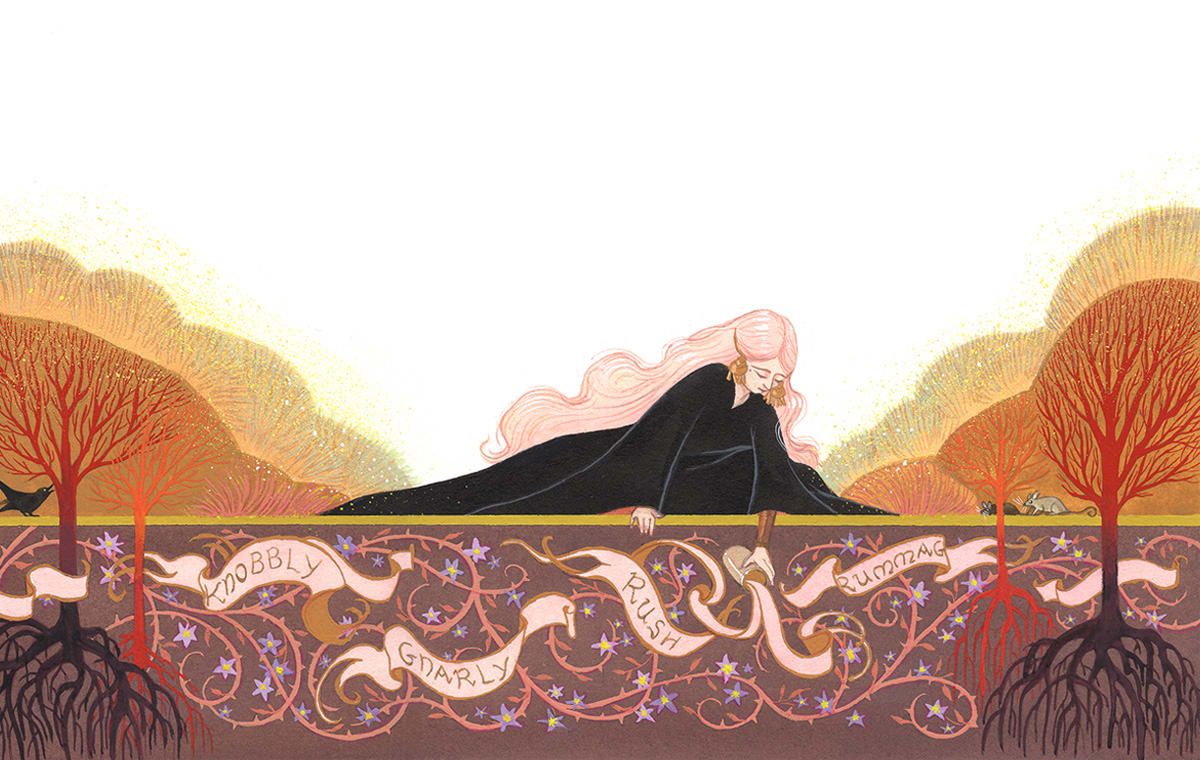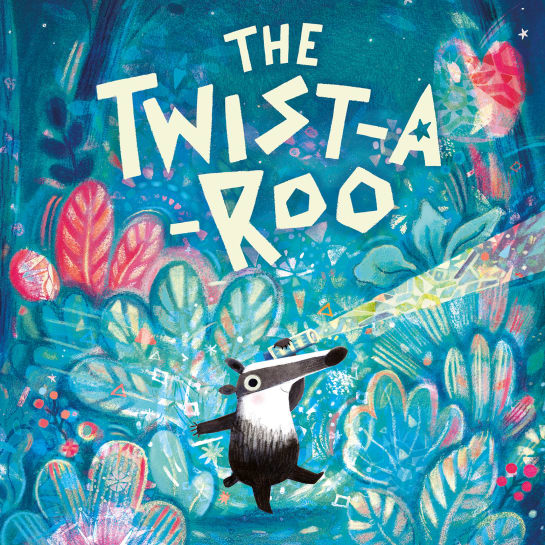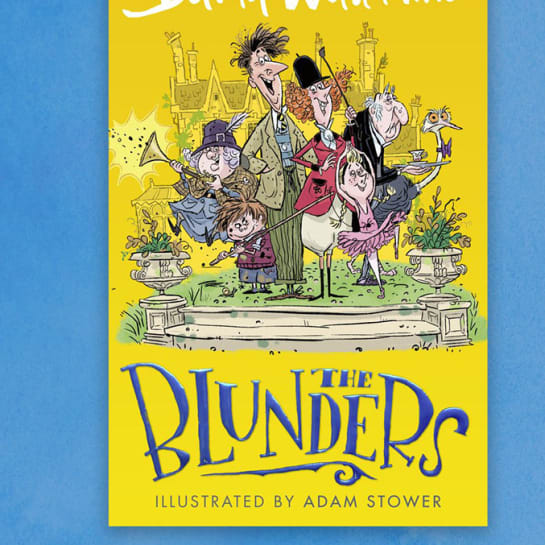With her delicate ethereal illustrative style Marie-Alice Harel was the perfect creative to illustrate Gaynor Andrews debut picture book Pandora and the Story Forge which publishes with Rocket Bird Books in September.
Pandora inhabits a magical world where she collects beautiful words from which she weaves and forges magical stories. Providing tales for all the children without stories, Pandora believes that once read, a story unfurls in your heart. A truly stunning and unforgettable debut, beautifully illustrated throughout will make this a must have for every picture book fan.

Heavily influenced by nature, animals and the countryside, Marie-Alice’s work often features flora and fauna in fantastical settings, so naturally she was the perfect illustrator to bring Pandora and the Story Forge to life. Her use of colour and light glow from every page, and her visualisation of the characters and creatures truly highlight her immense illustrative skills. We spent some time with Marie-Alice to find out more about this breath-taking project and how she went about interpreting the text.
Where to begin? The making of Pandora's illustrations
As always, the story comes first. I immediately loved the musicality and imagery of the text, how it is all at once free of burdensome descriptions and precise enough to bring the magical visions of Pandora's world to the mind. As an illustrator, this is both a blessing (freedom of interpretation! Endless possibilities! Space for personal exploration!) and a potential difficulty (endless possibilities, ugh! Too many options, where are we going?). This is one of the reasons why it took a while to find the right visual interpretation for this project.
I started with the character of Pandora. My first idea was to build on the metalsmith analogies built up in the text – forge, fire, wordsmith, hammer – and represent her as a powerful, almost supernatural woman with fiery hair, clad in metal. A timeless Nordic deity.

Early development for Pandora, progressively refined and simplified.

The middle image was my first sketch of Pandora that felt right. I used photographs of the beautiful and hypnotic actress Tilda Swinton for reference. She has that presence and otherworldliness that Pandora needed. Plus a few more drawings of Pandora to get familiarized with her face and features.
At the same time, I was also considering how to best represent the fluttering words that she captures and turns into stories. This was the biggest challenge and uncertainty for this text. The way they are described, like wild animals living in a wild natural world, prompted me to combine stylized animal attributes with scroll-like bodies on which words could be written on. Both of these ideas and approaches were exciting and rich with possibilities, but proved to be unsuitable. First of all, they are too literal interpretations of the text, and distract from the actual topic: stories and storytelling. Then, I had a very uncomfortable feeling about the all the capturing, hoarding, hammering that those little creatures would be subjected too. As a deep lover of animals, for me this was a no-go. I did not want to portray and encourage brutality towards animals and the natural world, even as an allegory.
This process led us to a more gentle representation of Pandora and her world: she kept some of the metallic adornments (earrings, wrist cuffs) but became a more integral part of the magical world that she inhabits (instead of a visitor who exploits). The words lost their animal attributes to give more space for the stories and characters (animals, real and mythical!) that progressively take over the page, blurring the line between real and imagined.
This probably took more time, meetings and headaches than you imagine. But with the addition of Hopeful the Borzoi and his new friend the crow, we were finally ready to move on to the next stage, the thumbnails. There were many months of work and decisions ahead of us, but now we knew where we wanted to go.

First sketches of Pandora's companions and colour palette tests. Hopeful's friend was a magpie before she was a crow.

First thumbnails: figuring out the book format, text placement and narrative rhythm.

Each page was drawn in detail first and, once approved by the editor and art director, transferred onto watercolour paper.

I stretch the watercolour paper on a board and let it dry overnight before starting to paint with watercolour, inks, pencils and, occasionally, gouache and pastels.

I used a dip pen and permanent ink to draw these decorative dragons, then painted over with watercolour.

Some steps of the process for one of my favourite pages from the book.

The font used in the book is based on a hand drawn alphabet I developed, referencing Celtic medieval manuscripts. I would have loved to go more ornate but had to find a compromise for readability's sake.
Inspirations
For any book project, I spend quite a lot of time looking for visual inspiration. This is one of the first things I do after reading the text. I collect anything and everything that lights a little spark in relation to the story to illustrate. This pile of material, which I keep adding to throughout the process, progressively gets organized into thematic folders (colour, style, characters, locations etc...) and gets more and more focused. This helps me build up an image and feeling of what I want to achieve, and what I will keep as a guideline all the way through. If I feel lost or indecisive, it is there to remind me of the path.
For Pandora, the final art was especially influenced by the art of medieval illuminated manuscripts, Celtic designs and the paintings of the Nabis, a group of French artists who made a transition from Impressionism towards symbolism and abstract art at the end of the 19th century.
A creative is always influenced by their own life, experiences, and environment, whether they want it or not. I work from my home in Edinburgh, a little top floor flat with a window facing a tree (and parking lots and buildings that I try to pretend I can't see). It is quite small, the light is bad, working from my living room means no life-work separation... but, because the tree's branches almost touch my window, high above the ground, I made friends with families of squirrels, pigeons, doves, mice and the occasional magpie. The squirrels especially are regulars – I know them all by name, look and behaviour. They were here with me every day I worked on Pandora, and have been every day since. And you can bet that they gave me notes, while they were busy filling their warm little bellies with nuts and seeds.
Based in Edinburgh Marie-Alice has had a rather dramatic career change since relocating from France, where she worked as a scientist, she is now a full-time artist, tutor and lecturer. After winning the Book Illustration Award for her illustrations for Diana Wynne Jones' Howl’s Moving Castle her reputation for creating magical, transient illustrations have led her to work for clients including Aardman Animation, Bloomsbury Children’s Books and The Folio Society.
Pandora and the Story Forge publishes with Rocket Bird Books in September. Order a copy here.
You can find Marie-Alice on Instagram where she shares process work, beautiful images of the Scottish countryside, handmade books, apparel and her latest’s projects. View her stunning artwork for Pandora and the Story Forge and the rest of her online portfolio here.
For more information about our artists please email info@arenaillustration.com and keep up to date by signing up to our weekly newsletter.





